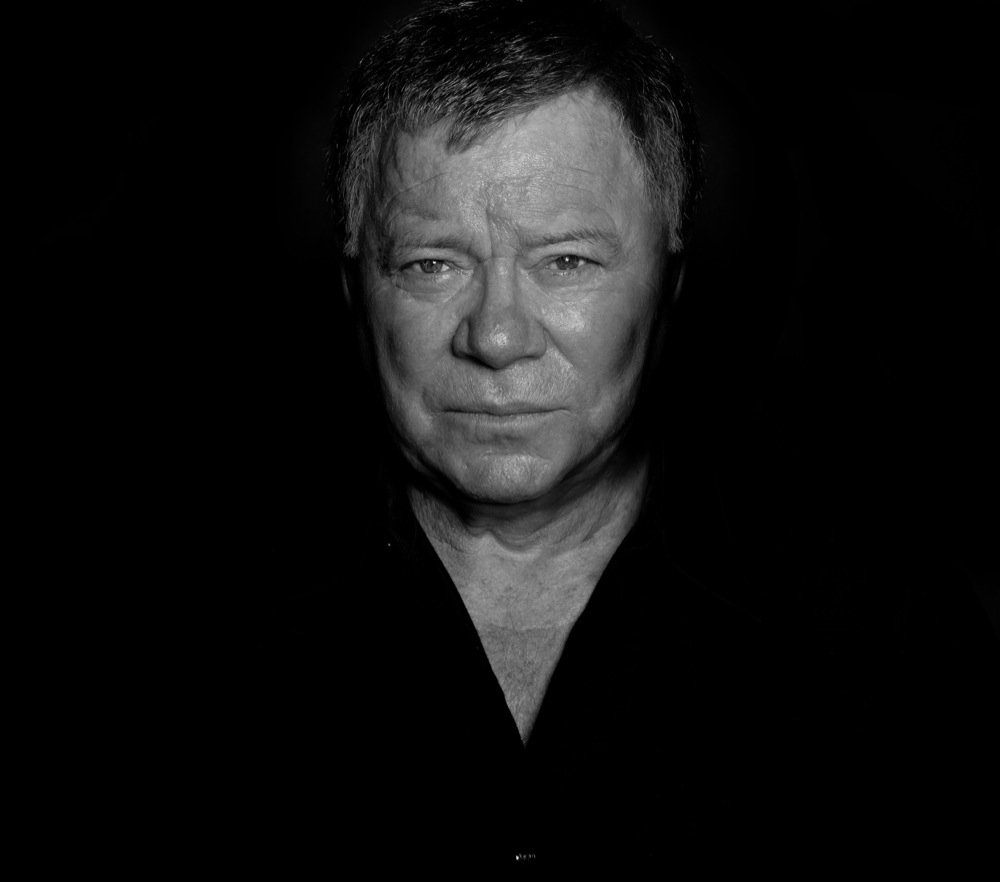William Shatner, Captain on the Bridge

ABOVE: WILLIAM SHATNER. PHOTO COURTESY OF MANFRED BAUMANN.
Mixed metaphors abound in Chaos on the Bridge, William Shatner’s recent hour-long documentary about the production of Star Trek: The Next Generation. Moving from a poker game played close to the chest to scenes straight out of the Wild West, Chaos on the Bridge reconstructs the turbulent first years of the Star Trek sequel series and the franchise’s embattled creator Gene Roddenberry. Animated sequences caricaturing the “chaos” of the show’s production break up the sequence interviews with those closest to Roddenberry. It’s an appropriate blend of images reflecting the behind-the-scenes conflict that defined efforts to get a reboot of the beloved series off the ground.
Though his role as James T. Kirk, captain of the Starship Enterprise of Star Trek in the original series, is a thing of the past, Shatner has remained engaged with the show and its various spinoffs. Chaos on the Bridge reunites the veteran writers, producers, and cast members of the series, many of whom Shatner also counts as close friends. He interviews familiar faces from The Next Generation, including Jonathan Frakes, Patrick Stewart, Gates McFadden, Diana Muldaur, and Denise Crosby, attempting to shed light on what exactly made those inaugural seasons in the late 1980s such a challenge to create.
At the center of it all is writer-producer Gene Roddenberry, who died in 1991 just four years after The Next Generation went on air. The portrait that emerges of Roddenberry is that of a brilliant but eclectic mind clinging for dear life to the greatest work of his career—the original Star Trek series. The Next Generation was Roddenberry’s search for a utopic future (series writers lament his conviction that crew members of the Enterprise could not have any conflict, making a compelling drama difficult) in a less-than-utopic present. And behind Roddenberry is his wild, overreaching lawyer Leonard Maizlish, a character who must be seen to be believed.
Now at 84, nearly 50 years after he wrapped on Star Trek, Shatner’s Twitter account is currently overrun with images of My Little Ponies photoshopped in the likeness of Captain Kirk. (The octogenarian possesses a social media presence that would put any millennial to shame.) But it’s of no relation to Chaos on the Bridge—instead, the ponies, many of whom sport standard-issue Starfleet uniforms, are part of an online scavenger hunt for charity organized by Supernatural alum Misha Collins. Shatner’s team placed second to Collins’s in the contest last year, but he has proved his renewed investment in this year’s competition. Last Thursday, he donned a Civil War-era costume as one of the scavenger hunt’s challenges, he said, and a few days ago Justin Bieber started following him on Twitter at Shatner’s request. (Is he a Belieber? “I’m an agnostic,” he reports.) We phoned in to speak with him shortly after the release of Chaos on the Bridge to discuss Roddenberry’s legacy, antics on the Star Trek set, and the late Leonard Nimoy.
KATHERINE CUSUMANO: I want to start with a pretty easy question—what’s your first memory of Star Trek?
WILLIAM SHATNER: [laughs] You think that’s an easy question, do you? Well, I guess the early memory was the first thing I’d heard about it. Gene Roddenberry called me on the phone, and asked me to take a look at a pilot that they had made with another actor, that they called Star Trek. NBC Network didn’t want to put it on the air, but they liked the idea sufficiently that they asked him to re-cast it, and he called me about playing the part of the captain.
CUSUMANO: There is a scene in Chaos on the Bridge when the series producers recall how Gene didn’t originally think that Patrick Stewart could be your successor. What was your impression of the “new Captain Kirk”? Did you know Patrick Stewart before they were casting him?
SHATNER: At that time, I had moved on, and I heard that they were going to do another series and they were casting Patrick Stewart, whose name I didn’t know. He was a wonderful actor at that time, but I don’t think his reputation as a wonderful actor had preceded him. He was an unknown quantity all the way around—both the way he looked and the way he performed.
CUSUMANO: How did you react when you heard that Star Trek would be revived for The Next Generation?
SHATNER: Well, I was glad, and there was an element of sadness that it had gone on without me. But at the same time, you know, I had a really great run with it, and I was alright, but I certainly was sad to see it go.
CUSUMANO: What made you want to make this film? How did you realize that you had a story here?
SHATNER: Well, I had been working with a gentleman by the name of Maurie Hurley, and he’s the one, the grey-haired guy in the film who keeps saying everything was “wacky-doodle.” He’s a madcap Irishman, a very talented writer, and I had worked with him for several years on various things. I had acted in some, directed some, and had written with him on some. We were really good friends. I loved him very much. He’s recently passed on. He would tell me these terrible stories of what was going on with this television show, and finally one day I said, “That’s going to make a great documentary. Will you sit down and let me interview you?” He’s the heart and soul of Chaos on the Bridge. It’s his information and his dynamic personality that make the show.
CUSUMANO: You did not start watching The Next Generation until you started working on this documentary. What brought you to it?
SHATNER: First, Maurie Hurley—and then I had to acquaint myself with what everyone was doing, the actors and all. Most of those actors on The Next Generation are friends of mine. I watched some stuff, but of course not seven seasons.
CUSUMANO: I have actually seen all of it.
SHATNER: Come on!
CUSUMANO: I have. You should definitely get through the whole thing.
SHATNER: I will, in due time. My time is shorter than yours, though.
CUSUMANO: Is the Roddenberry described to you in the documentary consistent with the man that you knew?
SHATNER: Well, Gene Roddenberry was a conflicted man in many ways. He was a writer, primarily, and writers are a solitary bunch. They sit at a keyboard and type away, and they get things out of their imagination. And then there’s a producer part that is the exact opposite. You have to put out the emotional fires, and you’ve got to be gregarious and schmooze and talk. That’s the exact opposite of the writer. When you make the writer a producer, so he’s a writer-slash-producer, you’ve got a real conflict in human terms. And that was part of Gene’s conflict. The problems they had on Chaos on the Bridge are problems of production and people. This machine that works to turn out a segment of television every week—it usually takes seven or eight days, so you’re always behind once you’re on the air, you’re always losing time—it’s a meat grinder, and that meat grinder pushes everybody under. It’s just a matter of when and how. The tensions and the anxieties and the stresses are so much in order to make a good hour of television every week, and that’s what I’m trying to delineate on Chaos on the Bridge, and I certainly felt it on the Star Trek I knew.
CUSUMANO: In the documentary, it seems like he really desperately wanted to present a utopia in The Next Generation. What is your view of the future? Where do you fall on the utopia-dystopia spectrum?
SHATNER: I’m on the other end of that pole, unfortunately. I think that we have so much inertia about correcting the ills of the world. I love the theory of Gaia, which is the earth is a living entity, and we’re little bugs of Gaia, and Gaia’s going to have a fever soon and shrug us all off.
CUSUMANO: Jonathan Frakes mentions that Patrick Stewart was not super impressed by the cast’s various antics on set. Do you remember any similar instances on the set of the original series?
SHATNER: Yeah, we goofed around quite a bit. Although I must say that Leonard, playing the serious part of Spock, stayed in character as long as he could, so my job in life was to try and crack him up. I took that very seriously. So I played as many practical jokes on him as I could. We goofed it up quite a bit on the original set.
CUSUMANO: Did he crack?
SHATNER: Every so often, both his eyebrows went up.
CUSUMANO: You are also working on a book about him. How is that going?
SHATNER: It’s going very well. I had a show on called Raw Nerve—I interviewed him then, and got some wonderful stories from him. Even earlier than that, I did an album called Mind Meld, in which I interviewed him exclusively. I’m looking at all the material that I have on him, and it’s quite an in-depth study of a lovely man. I’ll be done with it in two to three months.
CUSUMANO: You have also been pretty vocal about wanting to get back on board with some of the more recent incarnations of Star Trek. Are you going to be in the next film?
SHATNER: No, I will not be. Not that I wouldn’t want to be—I just don’t know how they would rationalize the difference in time and space.
CUSUMANO: They made it work with Leonard, so maybe there’s a spot for you.
SHATNER: I said to Leonard, “You know you’re old when you go back in time and you’re still old.”
WILLIAM SHATNER: CHAOS ON THE BRIDGE IS AVAILABLE VIA VOD.






